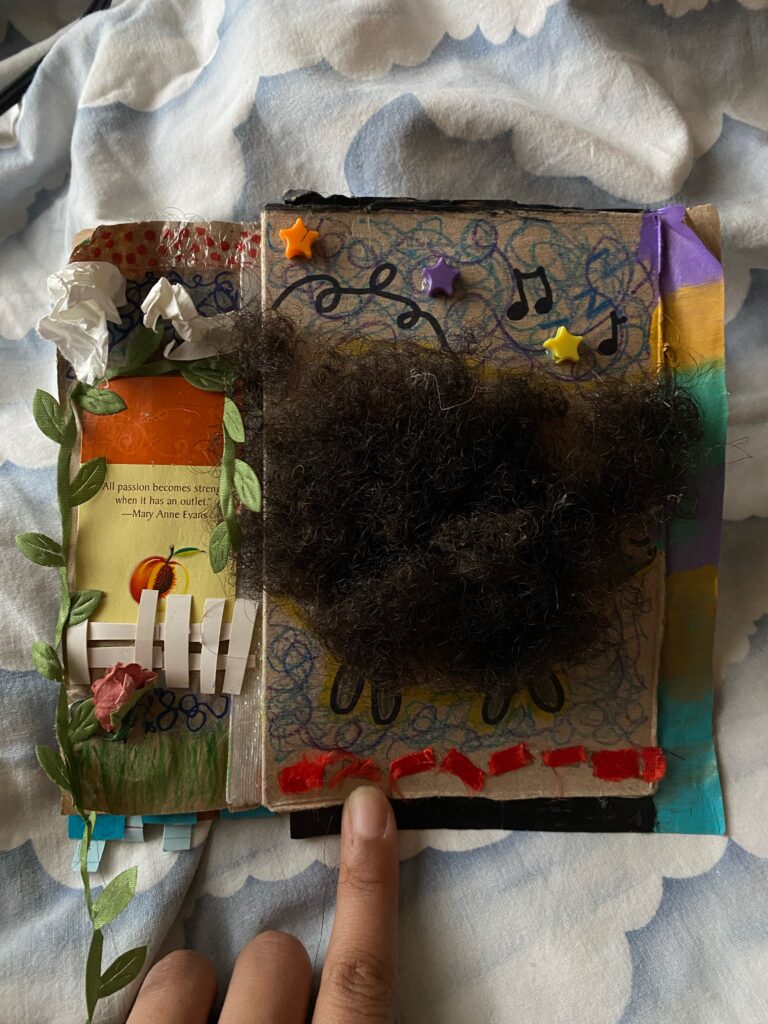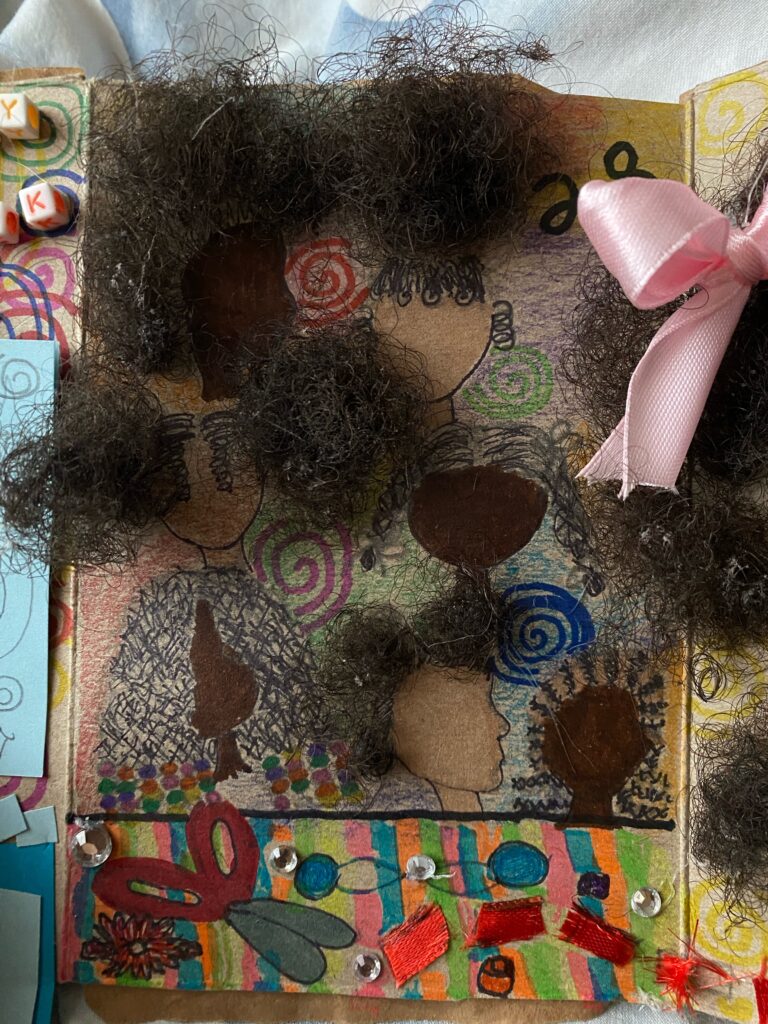By Miriam Intrator, Head of Archives & Special Collections and Rare Book Librarian
During the spring 2025 semester, students in RFM 1100 Fashion and Culture taught by Trina Gannon, Assistant Professor of Instruction and curator of the Mary C. Doxsee Historic Clothing and Textile Collection, had a hands-on session with rare books featuring textiles or focused on the history of clothing, fashion, and retail. Many of the books they viewed were artists’ books. These often include handmade or sculptural features and very personal content. Students were invited to engage with all the items in the room, seeking inspiration for an assignment to create their own book object or item, and to respond to three question prompts. Below are the creations and responses from four students in the class: Sloan Fullen, Mariko Cooper, Paige Currier, and Lauren Joseph.
Sloan Fullen
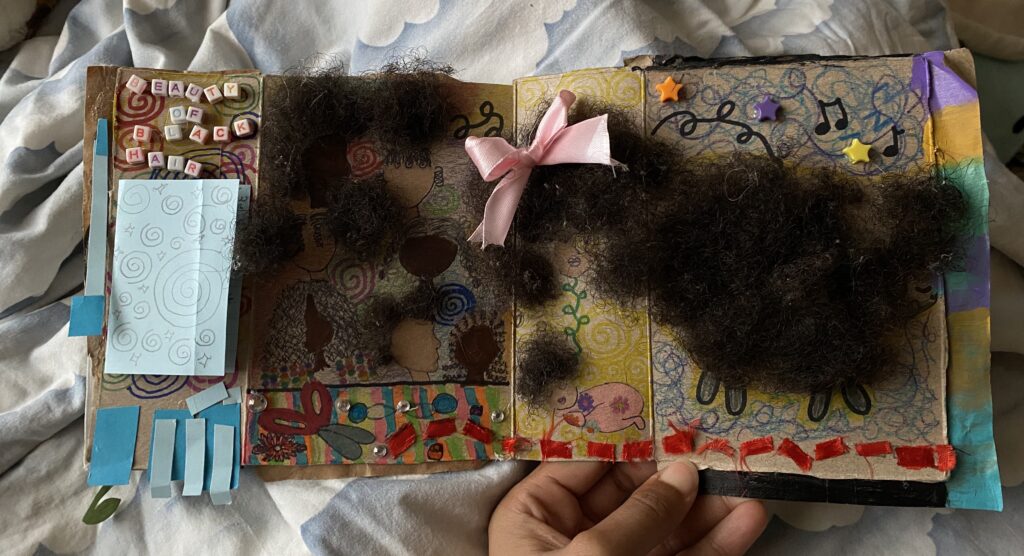
Three views of Fullen’s book. Each illustration features a different hairstyle created out of Fullen’s own hair.
1. What was it about your background/culture that inspired your sculpture?
I grew up with Afro texture hair & it’s always been a huge deal to everyone. I hated my hair growing up. People used to always tell me that I should straighten my hair. I currently have a love/hate relationship with my hair but it’s more love as I’ve grown into it & myself. It helps that I don’t have people telling me what I should be doing with my hair anymore as that’s always been a problem. I didn’t know how to take care of my hair til high school. That’s why I had such a hard time. No one taught me & my mom who is white had no idea how to do Black hair. I still sometimes feel I don’t know what I’m doing is right for sure but I think it looks like it. I’ve never really had a chance to express my feelings towards my hair journey until this project which I’m very grateful for. It was very helpful in a way & made me very reflective which I can always appreciate.
2. How did your own story unfold in the creation you made?
I kind of just had an idea then went with it and added things I thought made sense to me. It unfolded through the long story I put on the back of it!! I felt like no one would really understand unless I explained it in words. but using my actual hair I glued & drew different Black woman with different hairstyles on one part, me as a baby with an Afro in the middle & a sheep for the cover with the wool being my hair. It sounds silly, but it is very relevant to my life.
3. What did you see in the collection at the library that inspired your own creation?
There was this miniature foot binding book [Colette Fu, Golden Lotus, Women’s Studio Workshop, 2022. Read more and see images on Fu’s website.] that I loved & wanted to make something similar. I made a sort of book thing. I remember the book cover being very textured & being wrapped like they would do in foot binding (WHICH IS SO BRILLIANT!!!). I knew I wanted some texture with my project so I used my hair!! My creation looks nothing like the foot binding book but it absolutely gave me inspiration.
Mariko Cooper
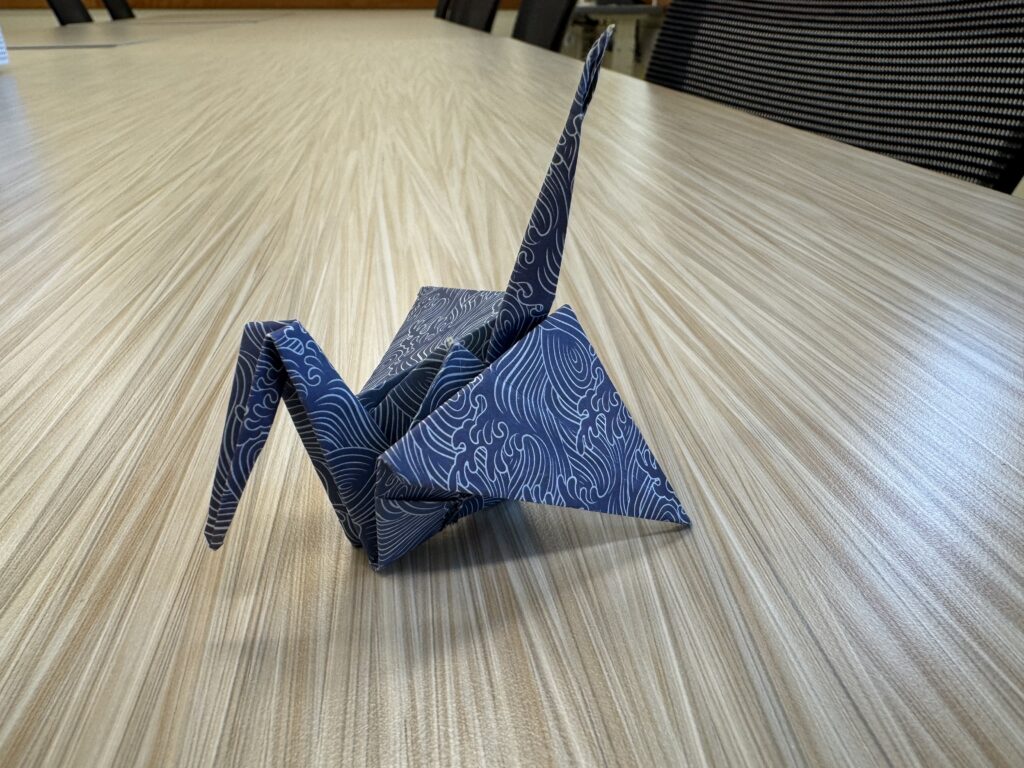
1. What was it about your background/culture that inspired your sculpture?
My family immigrated from Japan to the US. My cousins and I are the first generation born in the US and given citizenship for it. We also still have some family in Japan, however we have become very disconnected from them, the culture, language, and all else to do with Japan except for maybe the food.
2. How did your own story unfold in the creation you made?
While making this project I had difficulties determining what I felt comfortable writing of and talking about and what not. I tried to focus on my disconnect and struggle with identity due to not feeling “white enough” while also not “Asian enough”, leaving me often struggling to fit in especially growing up. While touching on this I recalled a memory from my youth with my family when my relatives visited and I was at my Grandmother’s home, I was so interested in their Japanese to English and English to Japanese books. My Aunt had an origami book and spent quite some time teaching me how to fold different shapes, the two that were most memorable were a “Samurai Hat” and a crane. There is a belief in Japan that folding 1000 paper cranes, senbazuru (千羽鶴), for a wish will grant it.
3. What did you see in the collection at the library that inspired your own creation?
The “origami” book in the library inspired my creation [Sandra McPhearson, Designating Duet, Janus Press, 1989. Read more and see images from Skidmore College and University of Wisconsin, Milwaukee].
Paige Currier

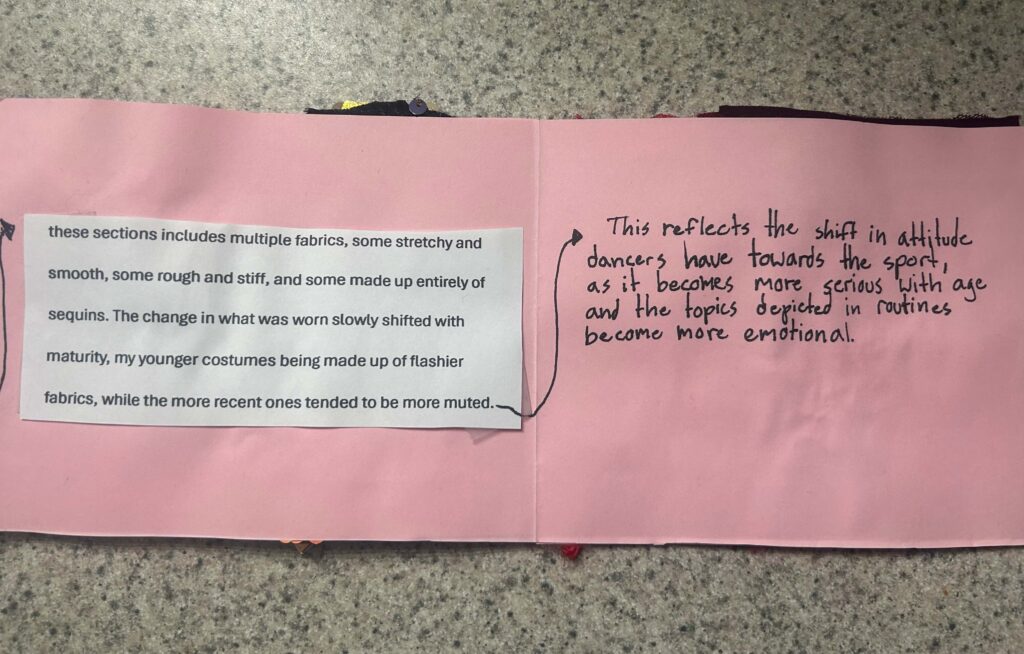

1. What was it about your background/culture that inspired your sculpture?
My sculpture/book was inspired by my background as a dancer. I chose this because I had danced for 16 years, and while I am no longer partaking in any form of dance, I still love it just the same! Without those experiences, my appreciation and love for the art would be nowhere as important to me as it is now.
2. How did your own story unfold in the creation you made?
I told this cultural story by using fabrics and hairpieces that I had worn in my years of dancing, being sure to include ones from each style that I did (ballet, jazz, hip hop, gymnastics, and musical theater). I also created a ballet slipper out of tissue paper on the cover of my book, to give an idea of what the inside contains.
3. What did you see in the collection at the library that inspired your own creation?
I do recall seeing a few pieces that had fabrics or textiles on the inside, or on the cover, which inspired me to take some of my old dance costumes that I had stored away and cut them up and include them in this project! [Sandra McPherson, Beauty in Use, Newark, VT: Janus Press, 1997. Read more and see images from University of Wisconsin, Madison].
Currier was also inspired by an original costume from Kaleidoscope, a dance choreographed by Alwin Nikolais that Premiered in 1953 at the Henry Street Playhouse in New York.
Lauren Joseph
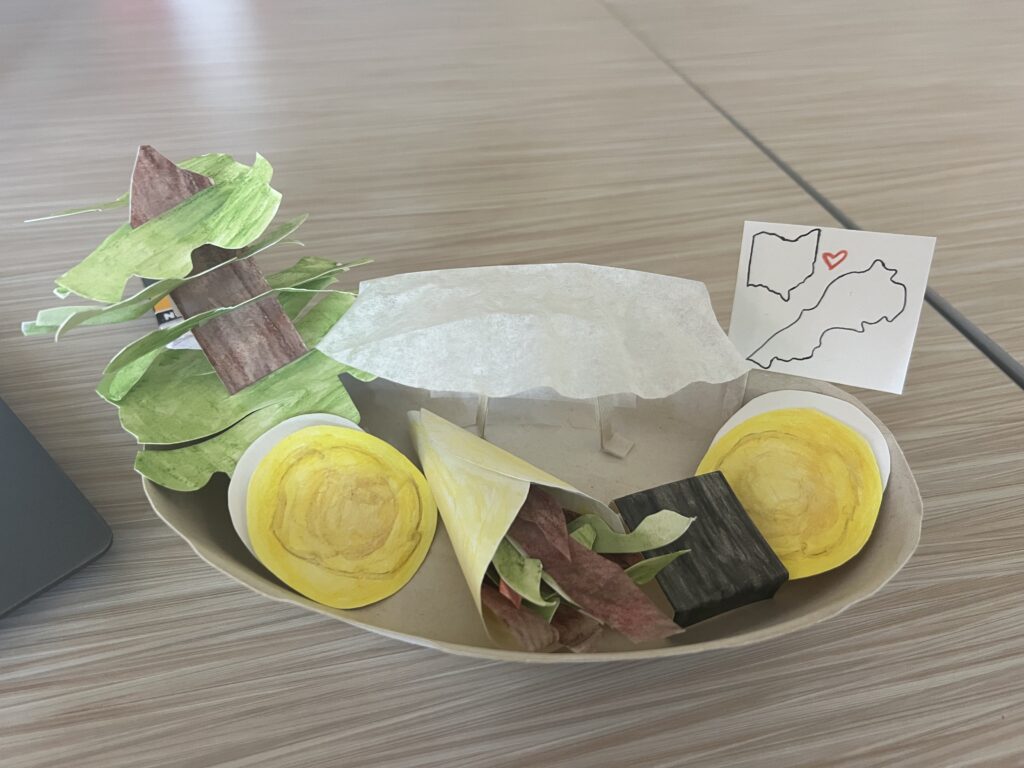
1. What was it about your background/culture that inspired your sculpture?
Growing up in Lebanon, Ohio and having a Lebanese upbringing with traditions and food and culture, I wanted to create the Lebanese festival held in Dayton, Ohio that my family attends every year.
2. How did your own story unfold in the creation you made?
It created a sense of connection between my life here and how far my family has come since immigrating.
3. What did you see in the collection at the library that inspired your own creation?
The book split in half with the evolution of clothing [James Riddell and John Berry, The Farce of Fashion, London, Riddle Books, circa 1940s].
Explore all the other books from the class session:
Islam Aly, The Tapestry of the Dreamweaver, Cairo, Egypt: Islam Aly, 2023.
Charlotte Hawkins Brown, The Correct Thing To Do-To Say-To Wear, Palmer Memorial Institute (Sedalia, N.C.), 1940.
Butterick Publishing Company, Butterick Fashions, Winter 1914-1915, New York, NY: The Company, 1914.
Costumes of America, Philadelphia: C.G. Henderson & Co., 1852.
Helen Gilbert Ecob, The Well Dressed Woman: A Study in the Practical Application to Dress of the Laws of Health, Art, and Morals, New York: Fowler & Wells Co., 1892.
Candace Hicks, Common Threads XC, 2018.
Household, Brattleboro, VT: Geo. E. Crowell, 1885.
Catherine Alice Michaelis, A Revealing History of Women’s Underwear, May Day Press, 2007.
Mary P. Merrifield, Dress as a Fine Art: With Suggestions on Children’s’ Dress, Boston, J.P. Jewett and Company; Cleveland, Ohio, Jewett, Proctor, and Worthington, 1854.
Frances Theodora Parsons, How to Know the Ferns: A Guide to the Names, Haunts, and Habits of our Common Ferns, New York: C. Scribner’s Sons, 1899.
Frederica Postman, Fashion Statements, P’Nye Press, 2005.
Annemaree Rea, Paper Dolls: Stories from Women Who Served, San Francisco, CA: Shotwell Paper Mill, 2013.
Carol Schwartzott, A Brief History of the Fan, Lilliput Press, 2003.
Carol Schwartzott, A Brief History of Knitting, Lilliput Press, 2006.
Christina Steffens, Friendship Album, 1874-1885.
rhiannon skye tafoya, Ul’nigid’, Women’s Studio Workshop, 2019.
